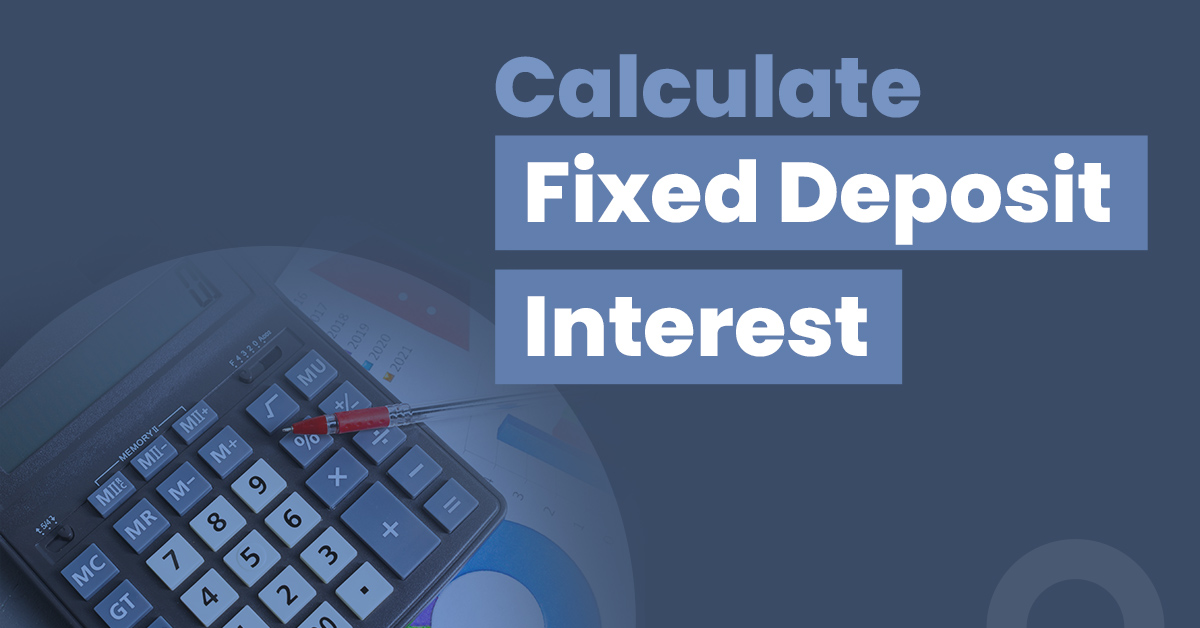How to Calculate FD Interest?


A fixed deposit (FD) scheme is a popular investment instrument because it promises guaranteed returns. Your deposits earn interest over a fixed period at predetermined interest rates. Hence, the interest income earned from an FD helps you create a guaranteed corpus for your financial goals.
But on what factors does the rate of interest for an FD scheme depend? Let’s take a look.
- The deposit amount
The interest rate will differ based on your deposit value. For instance, deposits above ₹2 crores will attract a better rate than those below this figure. - The term
Under the FD scheme, you can choose a tenure between 7 days to 10 years. Interest rates will vary based on what term you are choosing. - Age
Senior citizens are entitled to higher interest rates than depositors who have not turned 60 yet. - Financial Institution
FDs are offered by banks, post offices and Non-Banking Financial Companies (NBFCs). Each of these institutions offer interest rates different from the other. Usually, NBFC FDs fetch a higher interest rate. In the case of bank deposits, the rates typically differ from one bank to the other. - Type of deposit
Fixed deposits can be cumulative or non-cumulative based on the framework for interest payouts. In cumulative deposits, you receive the interest income as a lump sum on maturity. In case of non-cumulative deposits, the interest is paid periodically all through the tenure.
The compounding frequency determines the interest income you will earn during the tenure. The more frequently the interest is compounded, the higher would be the returns and vice-versa.
Let’s now understand how to calculate FD interest.
How is Fixed Deposit Interest Calculated?
The interest in a fixed deposit scheme is calculated either as simple interest or compound interest.
Under the simple interest model, the interest is calculated on the amount that you deposit.
Compound interest comes into effect when the interest earned on a deposit gets added back to the capital. The subsequent interest is calculated after considering both principal and the accumulated interest. In other words, your interest earns more interest.
Let’s understand how to calculate the rate of interest on FD using two simple formulae.
Also Read: Experience financial growth with unmatched Bajaj Finance FD Rates
Simple Interest Formula for FD Interest Calculation
Interest = Principal X Term X Interest Rate.
So, if you invest ₹50,000 (principal) in a fixed deposit for a term of 2 years at an interest rate of 5% per annum, the interest that you would earn would be as follows:
Interest earned = ₹50,000 X 2 years X 5% = ₹5000
Also Read: Post Office Fixed Deposit: Interest Rate, Tenure and More
Compound Interest Formula for FD Interest Calculation
The formula for compound interest is different. In this case, the amount that you get on maturity is calculated first. Then, this amount is deducted from the principal amount to get the interest.
The formula goes as follows:
Amount = Principal * (1 + Interest Rate) ^ Term
If the interest is compounded more than once a year, the formula changes to the following:
Amount = Principal * (1 + Interest Rate / compounding frequency) ^ (Term * Compounding frequency)
Deduct the calculated amount from the principal and you get the interest income.
For example, if you deposit ₹50,000 for 2 years and the interest rate offered is 5%, the compound interest would be calculated as follows, assuming that the interest is compounded annually:
Amount = Rs.50,000 (1 + 0.05) ^ 2
= ₹ 55,125.
Interest earned = ₹55,125 – ₹50,000 = ₹5125
You can also break down the formula and calculate the interest for each year. So, if you use the same example where the deposit amount is ₹50,000, the term 2 years and the rate is 5%, here’s how to calculate FD interest for every year:
- For year 1
Interest for the first year = 5% of ₹50,000 = ₹2500
Deposit value after the first year = ₹50,000 + ₹2500 = ₹52,500. - For year 2
Interest for the second year = 5% of ₹52,500 = ₹2625
Deposit value after the second year = ₹52,500 = ₹2625 = ₹55,125
Also Read: Find the monthly FD interest that you can earn on an Rs.1 crore FD
Things to Keep in Mind
When calculating the interest income from the fixed deposit, here are a few things you should keep in mind:
- The compounding frequency is an important criterion in calculating the interest rate. So, check the frequency when you are calculating.
- The interest would vary depending on the term. So, check your deposit tenure to find the applicable interest rate.
- If you choose the non-cumulative fixed deposit scheme, the interest income will be paid to you throughout the deposit term. You can choose the payout frequency at your discretion.
- There are online FD calculators that help you calculate the expected interest income. These calculators are free of cost and can be used for instant results if you do not want to do the calculations yourself.
- Comparing the fixed deposit schemes offered by different financial institutions is better. This would help you find the best interest rate on your deposit, thus maximising your returns.
Also Read: Cumulative FD: A Detailed Guide
Final Thoughts
The interest income earned on fixed deposits is what makes up your profit from such an instrument. Hence, it is crucial to explore and compare the various interest rates offered by financial institutions. In addition, knowing how the interest rate on FD will give you an understanding of your returns in real-time, helping you plan more efficiently for your goals – long-term and short-term.
FAQs
How to calculate the interest for an FD of ₹1 lakh for 2 years if the rate is 6% and interest is compounded quarterly?
To calculate the amount you will earn on maturity, the formula is as follows:
Amount = Principal X (1 + Interest Rate / compounding frequency) ^ (Term X Compounding frequency)
In this case, it would be calculated as follows:
Amount = ₹1 lakhs X (1 + 0.06/4) ^ (2 X 4)
= ₹112,649 (rounded-off)
The interest would then be calculated by subtracting the amount from the principal.
Interest = ₹112,649 – ₹100,000
= ₹12,649
Thus, you would earn an interest of ₹12,649 in 2 years on your deposit of ₹1 lakh.
Is the interest income from a fixed deposit taxable?
Yes, your interest income would be taxed in your hands as per your tax slab. This means that if you fall in the 20% tax bracket, you would have to pay a tax of 20% on the interest income.
For senior citizens, however, Section 80TTB of the Income Tax Act, 1961, provides tax benefits on the interest income. Under the section, interest income up to ₹50,000 can be claimed as a deduction from taxable income. Thus, no tax is payable on the interest income if it is below ₹50,000.
What is the rule for TDS deduction on the fixed deposit interest?
The rule for TDS deduction is as follows:
If you are below 60 years and the aggregate interest income from your fixed deposits exceeds ₹40,000, a TDS of 10% would be deducted from the interest income.
If you are 60 years or above and the aggregate interest income from your fixed deposits exceeds ₹50,000, a TDS of 10% would be deducted from the interest income.
However, if your taxable income is within the threshold limit of ₹2.5 lakhs, you can submit Form 15G/15H to the financial institution to get a TDS exemption.
Will the calculated interest income remain safe if the market turns volatile?
Fixed deposits give guaranteed interest, irrespective of market movements. So, the interest income would remain safe even during market volatility.
Are online fixed deposit calculators chargeable?
The online FD calculators are free of cost and help you arrive at an interesting estimate within minutes.







